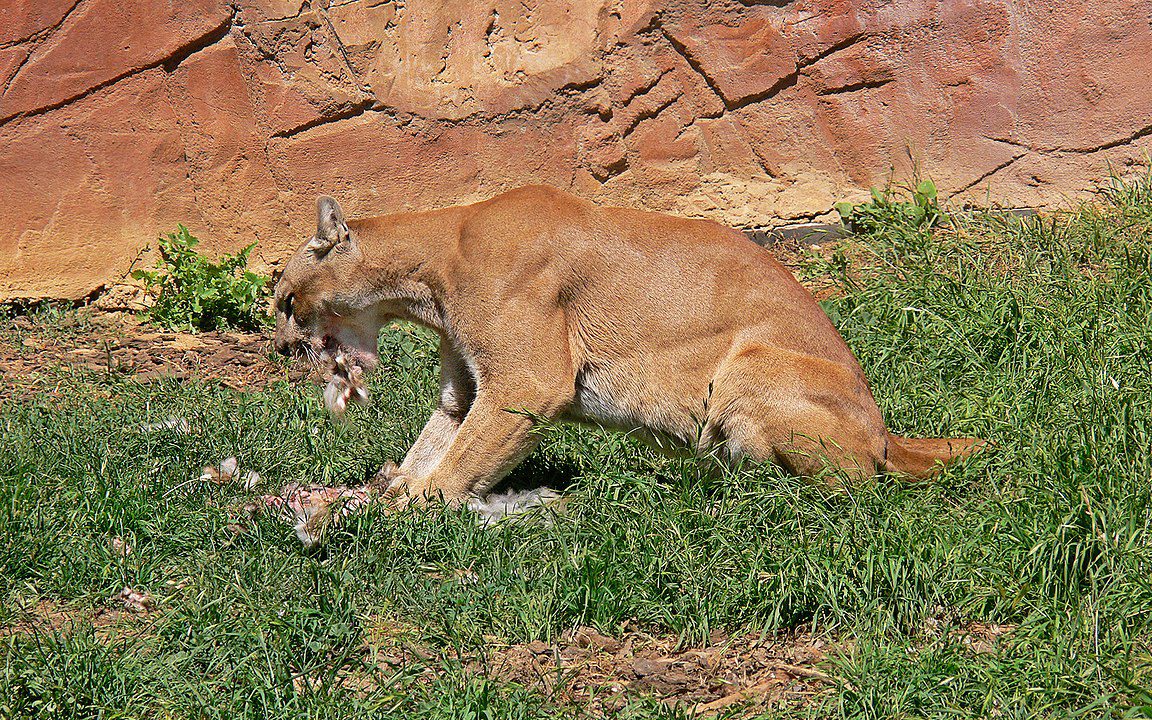Mountain Lions: 20 Things You Didn’t Know
In the extremely diverse world of feline species, the mountain lion is a rather extraordinary specimen that commands attention with its majestic presence and ferocity. It is scientifically known as Puma concolor, and this remarkable creature is a powerful and adaptable predator found across the Americas.
See 15 interesting facts about lions here!
It has several different names used interchangeably to refer to it, further reinforcing its diversity claims. Unlike their African counterparts, they thrive in a variety of habitats, from mountains and forests to deserts and grasslands.
This article will highlight some facts you may not be aware of about the mountain lion! Enjoy!
1. Mountain Lions Have the Most Names of Any Animal

Photo by Andy Holmes on Unsplash
The mountain lion holds the record for the most names of any animal on the face of the planet Earth. There are forty (40) different names that refer to the mountain lion.
These include Puma, Cougar, Panther, Catamount, Painter, Mountain Screamer, Mexican lion, Red lion, Ghost cat, and American lion. Very few animal species have such a diverse catalog of names that are widely recognized and used interchangeably across the world.
2. They are the 4th Largest Cat Species
On matters of size, the mountain lion falls behind three other feline species. These include tigers, lions, and jaguars.
On average, the adult mountain lion measures around 6 to 8 feet in length from nose to tail and stand about 2.5 to 3 feet tall at the shoulder. In terms of weight, they typically range between 100 to 220 pounds.
The record for the largest Mountain Screamer ever stands at 276 pounds! For comparison, the average human being weighs around 140 pounds.
See facts about another member of the feline family, the bobcat here!
3. Mountain Lions Are Solitary Creatures

Olivia Danielle Ruiz, CC BY-SA 4.0, via Wikimedia Commons
The puma is a solitary creature that prefers to live in solitude. They only come together with other mountain lions during mating season.
Even during mating season, the male and female will stay together for a few days before parting ways. After kittens/cubs are born, the female will raise them on her own before leaving them to fend for themselves when they mature.
They are also incredibly territorial and each will protect their own territory from other mountain lions.
4. They Do Not Roar

Malcolm, CC BY-SA 2.0, via Wikimedia Commons
Mountain lions are large cats but despite their powerful builds, they do not roar. Other big cats such as lions, tigers, and jaguars roar because of a specialized structure in the larynx.
However, the mountain lion does not have this structure. Therefore, instead of roaring, the mountain lion produces a variety of other sounds. These include hisses, growls, screams, and chirps which are used in different situations.
5. Mountain Lions Can Run Up To 50mph
Judging by the proportion of the bodies of animals in the feline family, mountain lions have the largest legs of the lot. This is an adaptive feature that helps them survive in most terrains but most importantly it helps with speed.
In a short burst, the mountain lion can reach speeds of up to 50 miles per hour! To put this into context, the fastest man on earth (recorded at least) moves at 27.33 miles per hour!
While it can only maintain this speed for only a short period, it is able to maintain speeds up to 10 mph for long-distance sprints.
6. They Give Birth to Up To 4 Kittens

Santa Monica Mountains National Recreation Area, Public domain, via Wikimedia Commons
Female mountain lions, or lionesses, typically give birth to litters of about two to three kittens. However, there are some cases where larger litters have been reported.
After 90–96 days(roughly 9 months) of pregnancy, the female puma gives birth, typically in a den or remote location. Due to a number of variables, mountain lion cub survival rates in the wild can be problematic. Limited resources and potential conflicts with other mountain lions are examples of this.
However, with the guidance and care of their mother, who nurtures and trains them in hunting skills, the cubs have a higher chance of survival.
7. Puma Cubs Are Born Blind and Have Spots

See page for author, Public domain, via Wikimedia Commons
The cubs of a mountain lion are born in an extremely vulnerable state. Puma cubs are born blind and remain so for about the first two weeks of their lives.
Interestingly, when the eyes do open, they are blue in color and shift yellow as the cub grows and matures. Other than the state of the eyes, mountain lion kittens are also different as they have dark spots on their fur.
In comparison, adult mountain lions have a uniform tawny brown coat. The spots fade as the cubs grow.
8. Mountain Lion Cubs Are Let Go by The Mother After About 2 Years
After the birth of the litter, the mother cougar will nature its cubs for 1.5 to 2 years before letting them fend for themselves. Over the course of about two years, the mother teaches her cubs essential skills for survival.
These include hunting techniques, territory marking, and how to navigate their environment. During this period, the cubs gradually become more independent, exploring their surroundings and honing their abilities.
At the time of separation from their mother, the cubs are usually close to adult size. Males weigh around 100 to 150 pounds while females weigh around 75 to 100 pounds.
While this may seem like sufficient time to learn, some cubs are not able to transition into solitary life and if not able to scavenge from the killings of others, they die.
9. Mountain lions Are Skilled Climbers

California Department of Fish and Wildlife from Sacramento, CA, USA, CC BY 2.0, via Wikimedia Commons
Cougars are popular for their ability as skilled climbers which enables them to navigate rocky terrain and even trees. One of their key adaptations for climbing is their muscular body, providing them with the necessary strength and agility.
Additionally, they have powerful hind legs and sharp retractable claws which allow them to leap great distances and scale vertical surfaces. Climbing allows them to access great vantage points to spot their prey as well as track escaping prey even if they retreat atop trees.
10. Their Tracks Don’t Have Claw Marks

National Park Service from USA, Public domain, via Wikimedia Commons
One of the easiest ways to identify the tracks of a mountain lion is by looking for claw marks in their paw prints. Or rather the lack thereof.
Mountain lions can neatly retract their claws, like the majority of other cat species. Thus, unless you are looking in especially rugged terrain, you will not typically see evidence of claws in their tracks.
11. Mountain Lions Are Primarily Nocturnal

National Park Service from USA, Public domain, via Wikimedia Commons
Pumas are primarily nocturnal creatures. This means that they are most active during the nighttime which is when they also prefer to hunt.
Being active at night allows mountain lions to take advantage of the cover of darkness, enhancing their stealth and hunting abilities. Their keen vision and excellent night vision enable them to navigate and locate prey effectively, even in low-light conditions.
Also, by being active at night, the mountain lion s able to exploit the element of surprise, utilizing their exceptional agility, strength, and stealth to stalk and ambush prey successfully.
Read about the bat here, another nocturnal creature!
12. They Have Cultural Significance For Indigenous People
Mountain lions hold a significant place in the culture and mythology of many indigenous peoples. These majestic cats are revered and respected, often representing strength, power, and even in some cases bad omens.
They feature prominently in indigenous mythology, appearing in stories and legends highlighting their cunning, agility, and mystical qualities. Mountain lions can also be found in traditional artistic depictions where their grace and beauty are truly captured.
13. Capable of Surviving in Diverse Environments

CindyLouPhotos, CC BY 2.0, via Wikimedia Commons
Mountain lions are highly adaptable species capable of surviving in various diverse weather and climactic conditions. This is why they can survive in the extensive range of environments across the Americas, from Canada to South America.
Although highly associated with mountainous terrain, (as the name suggests), they are not limited to these regions.
They can be found in various habitats including forests, deserts, and even coastal regions. Their ability to navigate and establish territories in different habitats contributes to their success as a species and their ability to survive in varied climates and ecosystems.
14. There Are 2 Subspecies of Mountain Lions
Until 2005, there were 32 recognized subspecies of mountain lions. However, in 2005 the list was reduced to only six due to the similarities of the earlier subspecies.
The list was revised yet again in 2017 to only two subspecies which are the only ones currently recognized. These are the South American Cougar and the North American Cougar scientifically called the Puma concolor concolor and the Puma concolor couguar.
15. Cougars Are Hypercarnivores

Benjamint444, CC BY-SA 3.0, via Wikimedia Commons
Mountain lions can be categorized as hypercarnivores since their diet is primarily meat-based albeit not exclusively. Their diet consists of several wild prey such as bighorn sheep, mountain goats, elks, and white-tailed deer.
However, while they do hunt these ‘big’ prey, they also go after the little guys in the wild such as smaller mammals like rodents, rabbits, and porcupines.
Typically, they ambush predators by stealthily approaching them and sprinting, catching the prey by surprise in most cases.
16. They Can Live For Up To Two Decades
Mountain lions have a lifespan that ranges between 8 to 13 years in the wild. However, in some cases, more so female cougars, there have been reports of some living up to 18 years.
In captivity, where they receive proper care and nutrition, mountain lions can live longer, with some individuals reaching their early twenties.
17. Mountain Lions are Sometimes Referred to as An Umbrella Species

Colorado State University Libraries, CC BY-SA 4.0, via Wikimedia Commons
A common term in the world of environmental conservation, an umbrella species is a species whose protection directly benefits other species as well. You know, like the umbrella protects anything beneath it?
As a result of the large and diverse habitats they occupy, their protection inadvertently means that many other different species also benefit from this.
18. They Rarely Attack Humans
Mountain lion attacks on humans are rare occurrences. These elusive creatures generally avoid confrontations with humans and prefer to keep their distance.
Whether it’s their choice to remain solitary or a natural fear and wariness of humans, there are very few instances of mountain lions attacking humans.
However, do not approach them as they are not friendly. If they feel cornered, they will attack without hesitation.
19. Mountain Lions Have a Poor Sense of Smell

K Fink, Public domain, via Wikimedia Commons
Pumas have a significantly weaker sense of smell in comparison to most predators and other feline animals. This is mostly because of their shortened muzzle which is that way to improve biting and griping with the mouth.
Even while it is far stronger than a human’s, a cougar’s sense of smell is still inferior to those of other members of the cat family. They compensate for this, though, with acute hearing and vision that enable them to spot evasive prey or approaching danger.
20. They Are Good Swimmers
Although they spend most of their time on land, mountain lions are actually good swimmers. They mostly use their ability to cross rivers and lakes and sometimes even catch fish, although this is not their primary source of food.
However, mountain lions rarely swim since they usually prefer to stay out of the water unless it is absolutely necessary. While occasionally swimming through fish, they do not rely heavily on fish in their diet or hunting methods.
In conclusion, the facts presented above more than underscore the significance of the species as a key player in the ecosystem balance. Their adaptability to various habitats and their role as apex predators contributes to the overall health and diversity of ecosystems across the Americas.
It is therefore crucial to recognize and appreciate their importance and ensure they are protected.
Planning a trip to Paris ? Get ready !
These are Amazon’s best-selling travel products that you may need for coming to Paris.
Bookstore
- The best travel book : Rick Steves – Paris 2023 – Learn more here
- Fodor’s Paris 2024 – Learn more here
Travel Gear
- Venture Pal Lightweight Backpack – Learn more here
- Samsonite Winfield 2 28″ Luggage – Learn more here
- Swig Savvy’s Stainless Steel Insulated Water Bottle – Learn more here
Check Amazon’s best-seller list for the most popular travel accessories. We sometimes read this list just to find out what new travel products people are buying.










